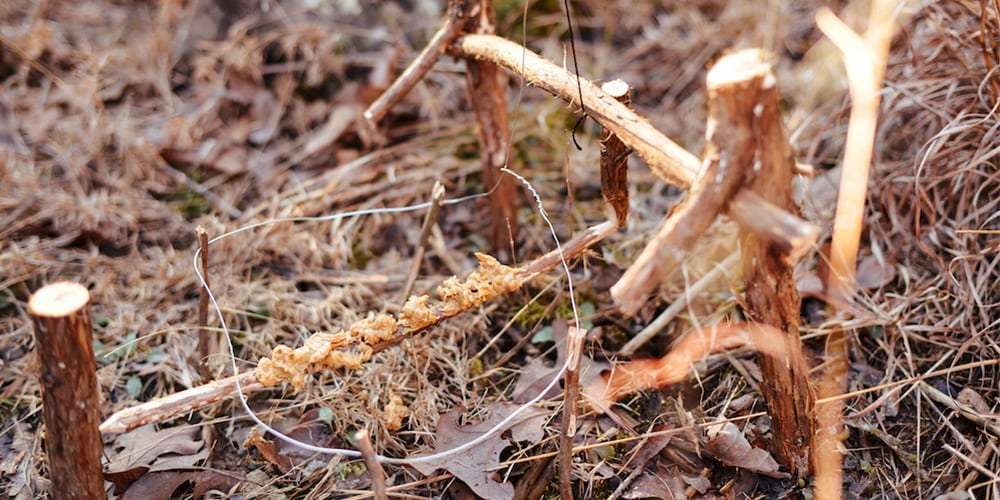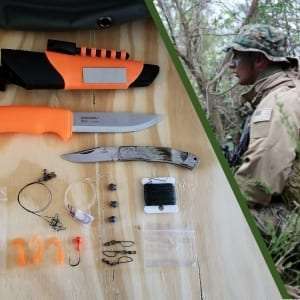Sure there are tons of articles and info out there on the subject of fatwood, so what makes this one different. In this article, we plan to reveal a few things you probably didn’t know about it and what works best when using it. This survival blog will even show you how to make it on your own if you can’t find any good fatwood.
What is Fatwood?
Fatwood, is a resin impregnated pine wood that can be found on pine trees and is probably the best natural fire starter available. It’s waterproof, rot resistant, extremely flammable, and in abundance when pine is in the area. Most evergreen trees contain terpene in their tree sap. This sap flows to an area that is scarred and damaged, attempting to heal that area. As the terpene evaporates in the sap it will harden, becoming resin and over time it will not be sticky any longer. The resin at all stages is flammable and burns well. This same resin can be used for pitch glue and all types of bushcraft needs.
Where to find fatwood?
The best way to find fatwood is to find fallen dead pine trees that are on the garound. When a tree dies the terpene in the wood will move to the interior heartwood of the tree and it will saturate the inner wood creating fatwood. Sometimes you can find sections of it the size of a small tree, within the inside of a large fallen rotten tree. You can also dig around rotten pine stumps to find large sections of it as well. Remove the punky rotten material from around the fatwood and this wood will be golden in color and very resinous in feel. You will also smell a heavy scent of turpentine in the wood and the stronger the smell the better the wood.
Fatwood can also be found in the lower branches of the tree in the small node that connects the branch to the tree. Where the tree connects to the trunk, is usually where it is found and most times it can be 2-6 inches in length out along the branch. Spruce fatwood is found only a couple inches up the branches and does not have as much fatwood as pine. Having some fatwood in a tinder box or tinder pouch , can be very useful in all type of weather conditions. So see if you can find some in your area then you definitely want to store it for later fire making uses. Fatwood makes a great tinder anytime, it will burn long and hot. When in wet conditions, its used for drying damp materials so they will combust into flame and this can make the difference with marginal wet tinder material. It will catch almost anything on fire if you have enough of it.
Other Uses
Large sections of it can also be used as a torch for lighting purposes around camp. Put the fatwood into the spears we make on the youtube channel and have a portable torch you can use for light in the woods. These can be used to attract fish for night time fish spearing as well! Since the fatwood puts off a tremendous amount of toxic smoke, this can also be used to combat mosquitoes in your camp. You do not want to breath fatwood smoke though, so caution should be used when in primitive shelters. Some people even take large sections of fatwood and make them into walking sticks so they are insured to always have a great firestarter.
How to make your own fatwood?
If you can’t find any fatwood in your area then you simply need to make some. It is so simple to make fatwood and you will have the same types of results as the natural fatwood. All you need do is melt your sap down in a container large enough to soak your sticks into. Once the sap is melted completely in the container, then add your finger sized sticks of cedar or dried pine to the melted sap. Lightly simmer the sticks in the sap for around 30 minutes and make sure you don’t get fire to hot or the sap will ignite into flame. Once the sap has soaked into the pre-cut sticks, then all you need do is let them air dry and they are ready for fire making.
You’ll need the following 3 items:
- Sap from pine, cedar, or fir tree
- Good flammable dry wood such as white cedar or dried pine
- Boiling container; preferably something you don’t mind ruining such as an aluminum can.
How to Prepare it?
Methods to prepare fatwood for fire starting is most commonly done in a two ways. The first is by taking a knife and thinly shaving off the fatwood to make shavings. The shavings should be thin and usually will be curled. A small pile the size of a golf ball or larger is a good amount. The shavings will light easily by using a flame or even sparks from a ferrocerium rod. The second way is by taking a sharp edge on the spine of a knife and scraping the fat wood to make a sticky dust. Also, the fine dust can be scraped off with a sharp stone, a piece of broken glass or other sharp object. After getting a small ball of dust in a pile you will be able to light this with a flame or ferrocerium rod. The SIGMORA (Official S3 Survival Knife) has a custom scraper on the back that makes perfect scrapings of fatwood for catching sparks and it is our preferred tool for this job.
Conclusion:
Fatwood is probably the single best fire tinder you can carry with you and is usually in great quantity if pines are in the area. This tinder is even better than birch bark and many modern tinders as well. It’s free, abundant, and one of the most useful fire making tinders you can harvest. Go out and get some and try it today!
This post may contain affiliate links which means I may receive a commission from purchases made through the links. I only recommend products I personally use and love, so if you support what we are doing, thanks for clicking.










